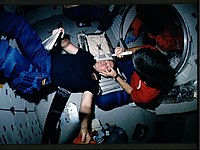
Photo from wikipedia
PURPOSE Cephalad fluid shifts in space have been hypothesized to cause the spaceflight-associated neuro-ocular syndrome (SANS) by increasing the intracranial-ocular translaminal pressure gradient. Lower body negative pressure (LBNP) can be… Click to show full abstract
PURPOSE Cephalad fluid shifts in space have been hypothesized to cause the spaceflight-associated neuro-ocular syndrome (SANS) by increasing the intracranial-ocular translaminal pressure gradient. Lower body negative pressure (LBNP) can be used to shift upper-body blood and other fluids towards the legs during spaceflight. We hypothesized that microgravity would increase jugular vein volume (JVvol), portal vein cross-sectional area (PV), and intracranial venous blood velocity (MCV) and that 25mmHg LBNP application would return these variables towards preflight levels. METHODS Data were collected from 14 subjects (11 male) before and during long-duration ISS spaceflights. Ultrasound measures of JVvol, PV, and MCV were acquired while seated and supine before flight and early during spaceflight at days 45 (FD45) and late (FD150) with and without LBNP. RESULTS JVvol increased from preflight supine and seated postures (46 ± 48 % and 646 ± 595 % on FD45 and 43 ± 43 % and 702 ± 631 % on FD150, p<0.05), MCV increased from preflight supine 44 ± 31 % on FD45 and 115 ± 116 % on FD150 (p<0.05), PV increased from preflight supine and seated (51 ± 56 % and 100 ± 74 %) on FD150 (p<0.05). Inflight 25mmHg LBNP restored JVvol, and MCV to preflight supine and PV to preflight seated level. CONCLUSIONS Elevated JVvol confirms the sustained neck-head blood engorgement inflight, while increased PV area supports the fluid shift at the splanchnic level. Also, MCV increased potentially due to reduced lumen diameter. LBNP, returning variables to preflight levels, may be an effective countermeasure.
Journal Title: Journal of applied physiology
Year Published: 2021
Link to full text (if available)
Share on Social Media: Sign Up to like & get
recommendations!